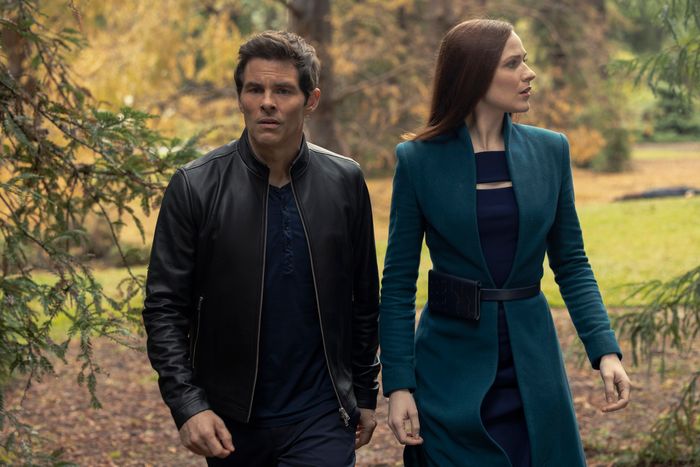
Recently, Warner Bros. Discovery has begun quietly and not so quietly removing titles from its streaming platform HBO Max. The first few big tranches earlier this year were a group of animated shows like Infinity Train and Summer Camp Island, children’s programs like The Not-Too-Late Show With Elmo and Tig N’ Seek, and several HBO Original series, including Generation, Mrs. Fletcher, Camping, and Vinyl. In December, Warner said that more shows would be removed from the platform, including Gordita Chronicles, Love Life, The Nevers, Minx, and Westworld, and Minx creator Ellen Rapoport noted several more announcements were yet to come.
On its face, this is a story as old as television itself. In its earliest years, TV was never something that would — or even could, in some cases — be preserved and watched again. For decades before the invention of the VCR, any TV show that aired on any given Tuesday night might never be available again, and certainly never in a way that viewers could control. Maybe that episode of The Defenders would play again in reruns and you’d have a chance to catch what you missed. But maybe not! Maybe you’d have to run out for an errand or your kids got in a huge fight and you had to go stop someone from bleeding. You’d never know how Lucy and Ricky made it out of that mess or who won that episode of The $10,000 Pyramid. It was an ephemeral medium.
Losing access to a handful of TV shows feels like a pittance, comparatively. There are still thousands of hours of TV series available to access whenever viewers want in more ways than have ever been possible before. You can stream House of the Dragon on your pocket computer while you commute to work! Many of those disappearing shows, like Mrs. Fletcher, are still available to buy digitally on other platforms, and a handful will likely pop up on other streamers down the line. What are people even complaining about here? And hey, if Warner is removing those series, surely that means no one was watching them anyhow, right? Plus, shows appear and disappear on streaming platforms all the time! This is just how capitalism works! [Elaborate insufferable shrug.]
And yet, shows like Minx and Love Life disappearing from HBO Max in 2022 feels different from the ephemerality of TV’s early history and even from the by-now-familiar dance of titles like The Office or Friends being removed from Netflix to stream exclusively on Peacock or wherever. There is no getting around the sensation of having and then losing something; it’s more frustrating and immediately insulting than the awareness that there are things you never had in the first place. On an emotional level, it feels like having a toy and then realizing the Lego corporation snuck into your room and took your toy back. Sure, you never had all the toys. Some of the toys aren’t getting made anymore. Some never made it into the Toy Subscription Program in the first place. Some were once in the program and then got removed because actually they were racist toys. (This is its own separate discussion.) But it is deeply annoying to believe you could watch HBO shows on HBO Max and then realize that, actually, that arrangement is conditional and you as an individual subscriber have no control over those conditions. You had something. It left! Ugh.
This is not an exclusively TV-related digital problem. Whole eras on the internet — blogs and profile pages, entire archives of nascent digital culture — once existed and are now lost. It’s not even a distinctly digital problem. There are thousands of 19th-century novels we have no copies of; there are centuries of Indigenous cultures that’ve been wiped out by colonialism; languages have gone extinct; the only truth is that everything ends, etc. Does that make it feel better when someone’s hard work disappears, though? Someone’s favorite show, someone’s fascinating academic primary source, vanished at the whim of an enormous corporation? No. It does not.
In the case of TV, that sense of loss goes beyond the baseline frustration. There was a period in not-so-distant memory when beloved TV series were regularly made available as physical releases. DVD boxed sets, and even VHS editions of TV series, were the first major bulwark against the vast and inexorable TV memory hole. With the ballooning number of TV shows produced each year and the market for DVDs cooling once streaming took hold, the hunger for physical copies of television shows has dried up. It’s one of the major differences between TV and movies on this front: There are certainly films that disappear from streaming platforms and never get DVD or Blu-ray releases, but collectors and film-preservation organizations like Criterion exist. There’s no comparable consumer-facing organization for older TV. Even the Paley Center, which has an enormous and impressive collection of TV that’s otherwise impossible to watch, is not in the business of distributing that collection beyond the physical confines of its NYC-based archive. (Sidenote: I desperately wish this is what Paley was all about! I would buy so many Paley Collector Edition DVDs of otherwise lost TV shows! I want a place where creators can nerd out in a giant closet of treasures and the video will go viral, and I want TV nerds to have their own fancy collector’s copies of Northern Exposure with all the original music intact.)
DVDs of TV shows are still being made, of course, and for big, popular series like Westworld, that’s still an option. But Westworld is the exception, not the rule. Shows produced by small studios, or made by and for streaming outlets like Apple TV+ or Netflix, are much less likely to have a physical release. (If Netflix decides to remove the incredible, canceled series Teenage Bounty Hunters tomorrow, there’s no DVD or Blu-ray or rent/purchase option on Prime or Apple TV. It is gone.) And just because a DVD existed as a listing somewhere at one point does not make it actually accessible. Any Amazon search will show you many listings for “currently unavailable” DVD sets. Even the DVDs that do exist are sometimes produced without any input from the original creators, which means there’s little oversight into what makes it on or how it’s presented. It can mean that creators have no physical copies of their own work. And if there’s no DVD or Blu-ray release, that also means it’s likely unavailable in public libraries, another traditional option for access to otherwise inaccessible media. So when shows disappear from streaming platforms, the feeling of a yawning void is all the more palpable.
There’s another element here, too. When TV appeared once a week, the rituals and rhythms of appointment viewing meant that although a show might vanish, there was at least one moment beforehand that was fully dedicated to its existence. In the age of newspapers printing TV listings, viewers who really wanted to watch something knew exactly when it happened. Even before then, the reality of the programming grid made television’s temporality crystal clear: In order to see what happened on NBC at 8 p.m., you had to watch NBC at 8 p.m. But streaming has turned TV into an amorphous, unending content blob. There’s no specific time to watch a show, no moment when it solidly exists as a cultural artifact. Each individual title becomes something like Schrödinger’s TV show, an option that sort of still exists as possible. Sure, you haven’t watched that show yet. But you haven’t not watched it, either — it’s still uncertain, still unresolved. But once a show is gone from its streaming platform, all that exists now is the realization it’s gone. For some shows, that period of nebulous possibility has become alarmingly brief; Minx was available for less than a year on HBO Max. At this point, it’s unclear when or where it will be available again.
Because streaming platforms have decoupled TV series from specific timelines of when to watch, the experience of watching TV now feels less like a time and more like wandering around a place. The word platform suggests somewhere physical, and that’s often what it feels like: arriving on HBO Max or Netflix or Prime and poking around, checking out all the submenus, considering the overall look, comparing how big this place feels compared with other streaming islands. The sensation of scrolling is not actually about moving through a physical space, but that’s how our brains register it — how long is this hallway of titles? How many doors are there, each with something exciting inside? The biggest loss is that the shows themselves are gone, but eventually, HBO Max may also find its subscribers starting to notice the island is shrinking. When titles disappear without warning, the whole space starts to seem less stable. The platform becomes a less reliable destination. For a few years, streaming felt like a massive, glorious new space for TV. It may actually be much smaller than we thought.





